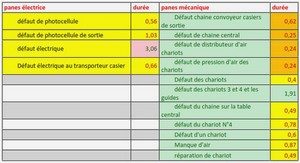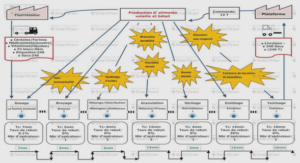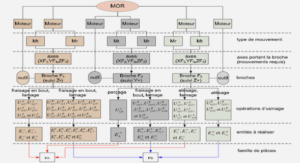The literature on time series of counts is becoming increasingly abundant, with applications in numerous domains (see e.g. the monographs by Christou (2014) and Liu (2012), and the references therein). It is common to assume a conditional Poisson distribution with the intensity parameter depending on the past values. This leads to models that are quite tractable , but extremely constrained, since their conditional variance and conditional mean coincide. Many extensions and alternative conditional distributions have been proposed in the literature, for example, Heinen (2003), Zhu (2011, 2012a,b,c) and Christou & Fokianos (2014), but either the conditional distribution remains relatively constrained or it contains extra parameters that are difficult to estimate and interpret.
In the present chapter we adopt a semi-parametric approach, in which only the conditional mean is specified. Since the works of Wedderburn (1974), White (1982), McCullagh (1983) and Gourieroux et al. (1984), it is known that certain maximum likelihood estimators (MLEs) can be consistent and asymptotically normal (CAN) for the parameters of the conditional mean and variance, even if the actual conditional distribution is not the one which is assumed by the MLE. In particular, the Gaussian quasi-maximum likelihood estimator (QMLE), in which the conditional mean and variance parameters are estimated by maximizing a pseudo-likelihood written as if the condition mean were Gaussian, is the method of choice for estimating autoregressive moving average-generalized autoregressive conditional heteroscedasticity (ARMA-GARCH)-type models. For time series of counts, the Poisson QMLE (PQMLE) can be employed to identify the conditional mean. This estimator has been studied by several authors for particular count time series models, for example, Zeger (1988), Zeger & Qaqish (1988), Kedem & Fokianos (2002, Chap. 4) and Christou & Fokianos (2014). In this chapter, we consider a quite general framework and give regularity conditions under which the PQMLE is CAN. We also consider the case where the aforementioned regularity conditions are violated because the parameter stands at the boundary of the parameter space. In that case the asymptotic distribution is not Gaussian. This situation must be considered for testing the nullity of some conditional mean parameters. For important classes of time series of counts, such as the integer-valued GARCH (INGARCH) models, the significance test statistics are not asymptotically distributed as a standard chi-square, but as chi-bar-square. The general results are applied to specific models, namely the integer-valued autoregressive (INAR), the INGARCH and the log-linear models, with different specifications of the conditional distribution. Thus, the main contribution of the present chapter is threefold. Firstly, the asymptotic theory of the PQMLE is developed for estimating the conditional mean parameters without having to specify entirely the conditional distribution. We complete the aforementioned existing results by considering a very general parametric form for the conditional mean, and by providing applications to linear or log-linear models. Second, the asymptotic distribution of the estimator is obtained without positivity constraint on the coefficients, which is new for count time series. Third, Wald-type significance tests are proposed. Due to boundary effects, the asymptotic distribution of these tests is not standard, but they can however be easily implemented and are obviously useful to model identification. These theoretical results are illustrated by Monte Carlo simulations and applications on financial data.
Asymptotic distribution
As expected, under mild regularity conditions, the Poisson QMLE turns out to be asymptotically normal when the parameter belongs to the interior of the parameter space. In the more general situation where the parameter may lie at the boundary of the parameter space, its asymptotic distribution is the projection of a Gaussian random vector on a convex cone. Estimators with similar asymptotic distributions have been studied by, for example, Andrews (1999), Francq & Zakoïan (2009b) and the references therein.
When θ0 belongs to the interior of θ
The asymptotic normality of the PQMLE has been studied by several authors (see in particular Christou & Fokianos (2014) and the other references cited in the introduction). The general framework of a conditional mean of the form (2.2.1) has however never been considered. Fokianos & Tjøstheim (2012) considered the MLE for a first-order Poisson nonlinear model. Here, we give conditions for the asymptotic normality of the PQMLE when the true conditional distribution is unspecified.
Numerical illustrations
The first part of this section examines the finite sample behaviour of the PQMLE. The second part presents a simulation study concerning the test of nullity of one coefficient and the test of constant conditional mean. All the results of this section are based on N = 1000 independent replications of Monte Carlo simulations of different sample sizes n. For each simulation, the first 100 observations are omitted, so that the process approaches its stationary regime.
Significance tests based on the PQMLE
We now report a Monte Carlo experiment for examining the performance of two adequacy tests for the conditional mean : the test that one coefficient is equal to zero, and the test of constant conditional mean. The simulation is implemented to obtain the sizes and the powers of the tests for different sample sizes. The tests are carried out at asymptotic level α = 5%.
Real data application
In this section, we report an application of the PQMLE to financial time series data. The data set is obtained from the QUANDL search engine and it contains the daily number of trades of 6 stocks listed in the NYSE Euronext group, namely CR.FONC.MONACO, Siraga, Technofirst, Siparex Croissance, Proximedia and Achmea . The size of the series varies from 1006 to 3633. with the exception of the PROXIMEDIA stock which is underdispersed. For each series, we fitted INGARCH(1,3), INGARCH(1,2) and INGARCH(1,1) models. The estimated parameters are shown in Table 2.8. This table also gives, into parentheses, the p values of the test (2.2.25) of nullity of the corresponding coefficient. The p-values that are less than 0.05 are displayed in bold. Recall that we used the function nlminb() of R to minimize the opposite of the log-likelihood function. The values of minimised function are provided in the rows « -Log-Like ». To illustrate the table, take the example of the daily number of transactions of the SIRAGA stock. For the full INGARCH(1,3) model with 5 parameters, the parameters α₀2 and α₀3 are not statistically significant. Among the 3 models with 4 parameters, the INGARCH(1,2) model and the constrained INGARCH(1,3) models (assuming α02 = 0 or α01 = 0), the first two models are the same and are prefered to the third because the likelihood is larger, but they contain a non significant parameter. Among the 3 models with 3 parameters, the INGARCH(1,1) has the largest likelihood and all its parameters are significant. Therefore, a conditional mean of the form λt = 0.201 + 0.258Xt−1 + 0.687λt−1 is retained for this series. In general, the INGARCH(1,1) representation seems the most appropriate for the majority of the series, except maybe for the TECHNOFIRST series which apparently could be better modeled by a INGARCH(1,3) with the constraint α2 = 0. Figure 2.13 (see Appendix) shows that the residuals of the selected models can be considered as white noises. It is interesting to note that, for all the series, the sum of the estimated values of the α and β coefficients is close to 0.9, which indicates a strong persistence in the dynamics.
1 Le contexte bibliographique et les contributions de la thèse 1 |





